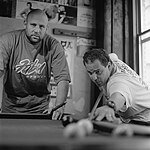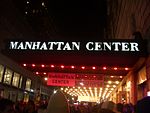The Tank (theater)

The Tank is a nonprofit off-off-Broadway performance venue and producer in Manhattan, New York. The organization was founded in May 2003 by a group of young artists and has since moved several times, residing on 36th Street as of 2017. The Tank presents art across several disciplines (comedy, dance, theater, music, film), produced at no fee for use of the venue to the presenting artists. The Tank houses two performance spaces (a 56-seat black box and a 98-seat proscenium) and five rehearsal studios. Beyond presenting work at its resident home in Manhattan, the theater has also produced shows performed elsewhere throughout New York City, collectively presenting over 1,000 performances each year. Between 2016 and 2018, five of the theater's shows were nominated for a total of six Drama Desk Awards and in 2020, the theater itself received an Obie Award for its work supporting emerging artists.
Excerpt from the Wikipedia article The Tank (theater) (License: CC BY-SA 3.0, Authors, Images).The Tank (theater)
West 36th Street, New York Manhattan
Geographical coordinates (GPS) Address Phone number Nearby Places Show on map
Geographical coordinates (GPS)
| Latitude | Longitude |
|---|---|
| N 40.75353 ° | E -73.993261 ° |
Address
Abingdon Theatre Complex
West 36th Street 312
10018 New York, Manhattan
New York, United States
Open on Google Maps






